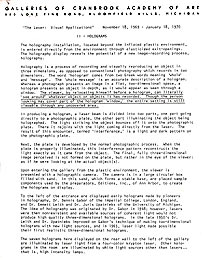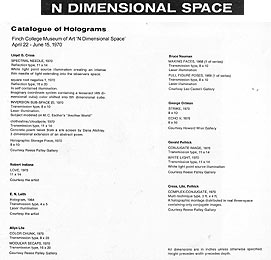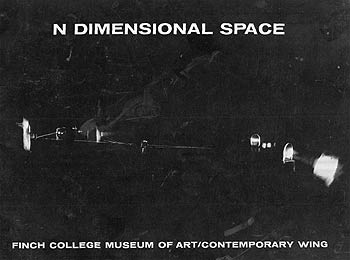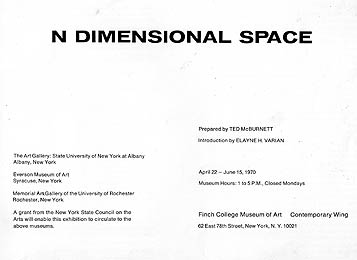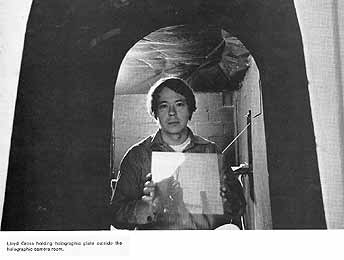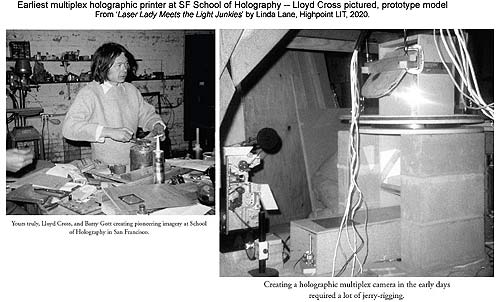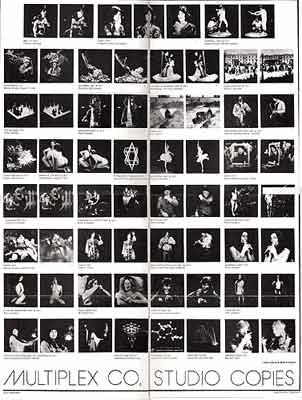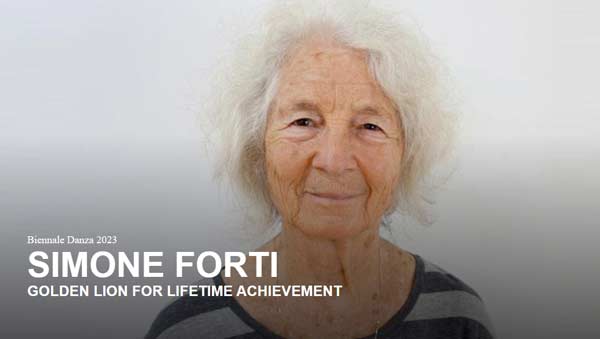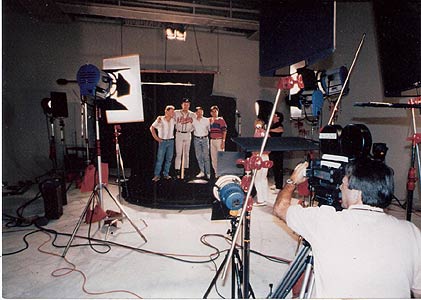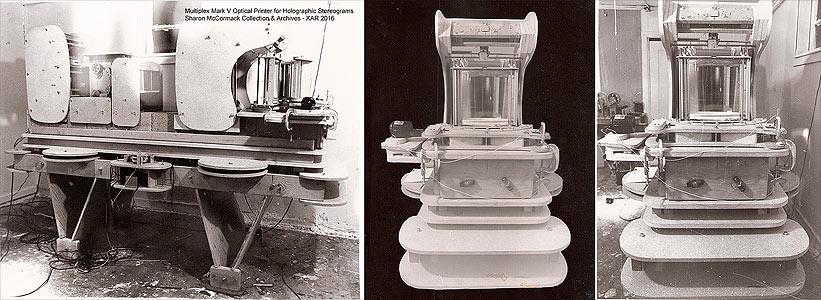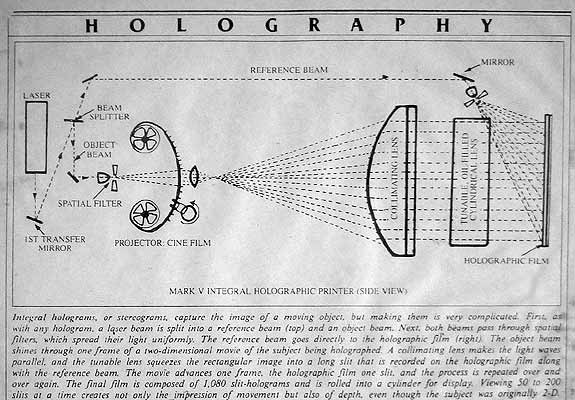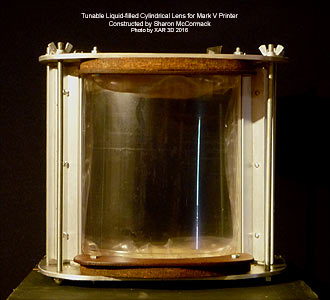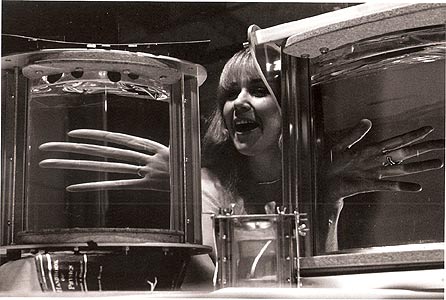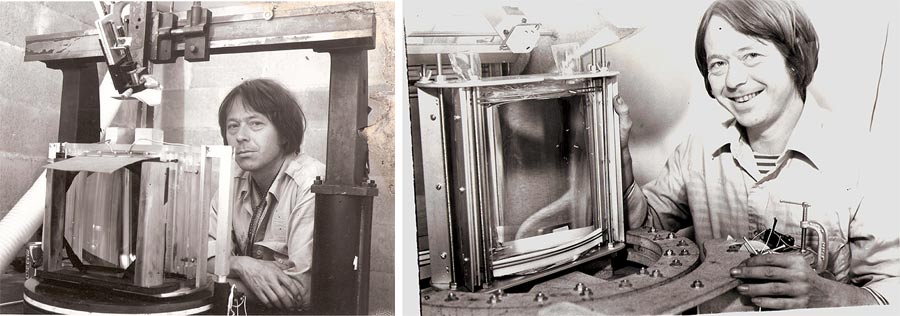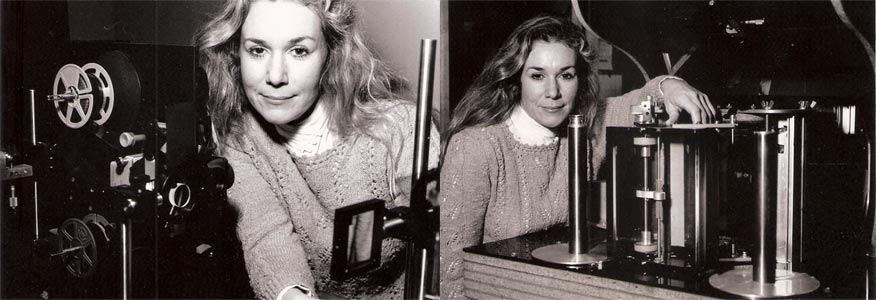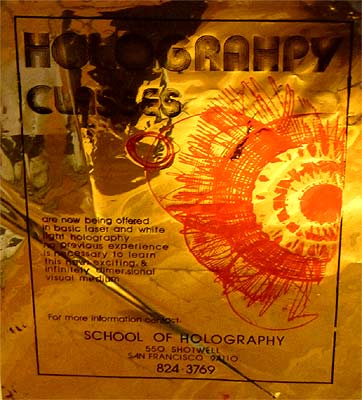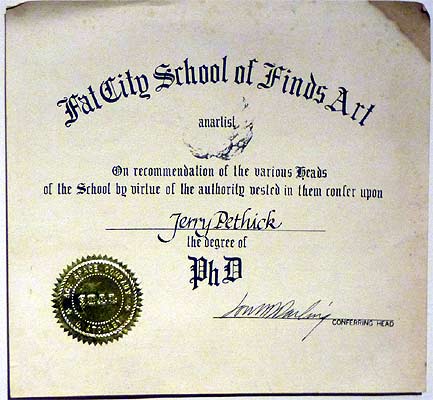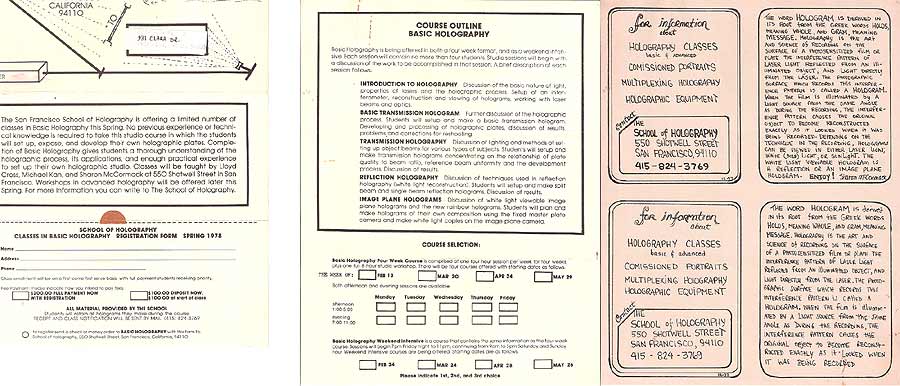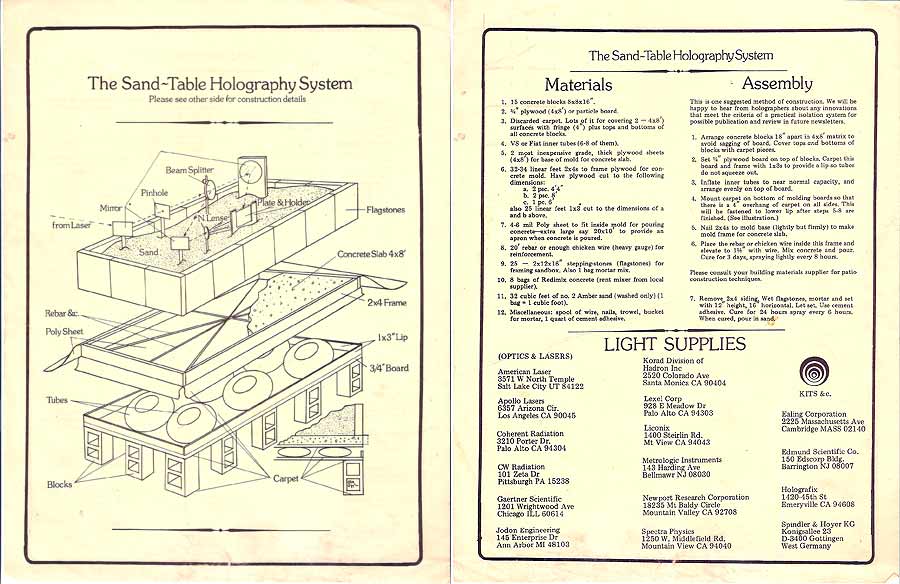Lloyd Cross
Scientist - inventor - educator - artist
Sharon McCormack Collection & Archives
Including History and Arts of >> San Francisco School of Holography,
>> Multiplex Company
MULTIPLEX (INTEGRAL) HOLOGRAPHY
The white-light viewable multiplex hologram, also called an 'integral hologram' was invented by Lloyd Cross, a physicist turned artist turned educator in 1971. This form of holography combined motion-picture frame sequences (shot photographically in 2D) with a form of projected (aerial) image holography in the making of spatially 'multiplexed' (thin strips of squeezed images set side by side in a row) transmission holograms, first laser viewable only, later viewable by white light. He demonstrated this invention and concept in a series of stages (and "Mark Series Printers"), first as a crude 40-image animation on a small piece of film, then as more sophisticated and larger displays made by more sophisticated automated printers, including the final displays illuminated by white light as a series of products that were marketed all over the world. His story reveals the beginnings:
"
... with our present technology we could not capture that incredible three dimensional scene with people and horses and so forth on a holographic plate. So, I became quite determined to at that time to do something about it, and of course one of the answers was multiplexing holography... I worked out the ideas to make an integral hologram from cine film at the Verde Valley School (in 1971)."
-- Lloyd Cross, inventor of multiplex (integral) holography
( as cited in pages 6 & 7, 'Story of Multiplex' and original patent unfiled application below )
U.S. Patent Application for original multiplex (integral) hologram printer by Lloyd Cross
-- 1973 draft copy - sample pages
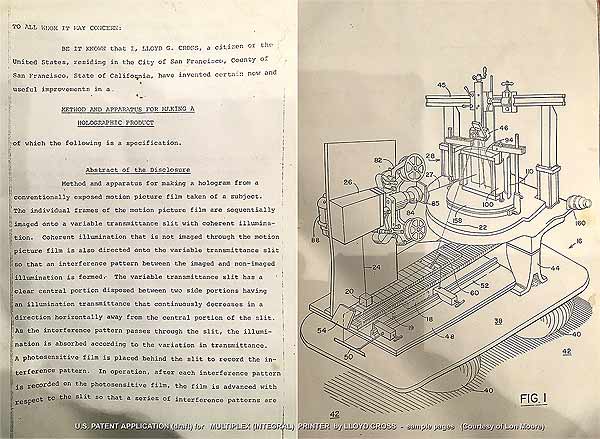
Download PDF copy
Multiplex Holographic Printer Patent Applicaton - by Lloyd Cross
- 21 pages, 1 illustration, document courtesy of Lon Moore
First person historical accounts:
'The Story of Multiplex' & School of Holography by Lloyd Cross (.PDF)
Photo of (l to r) Lloyd Cross, Michael Kan, the principal designer - builders of the multiplex hologram printer & lenses, and Dr. Tung Jeong from Wake Forest College Physics Dept, a visitor to the School of Holography - Multiplex Shotwell Street San Francisco building , circa 1974 photo. Source: Sharon McCormack Collection & Archives.
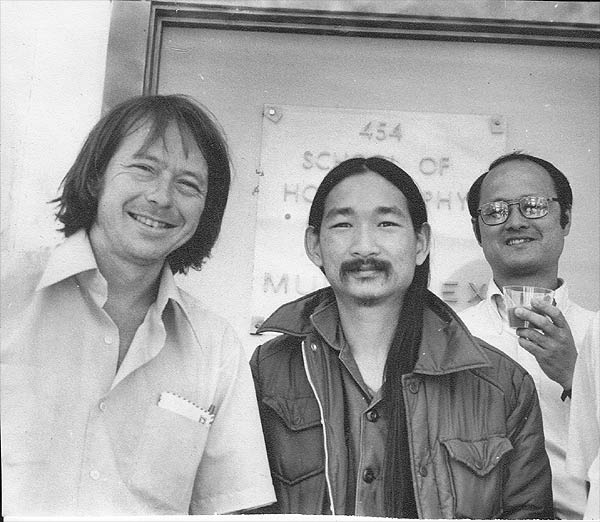
John Fairstein's recollections of The San Francisco School of Holography and working with multilex printers (this page below)
NOTE: the terms 'multiplex hologram', 'integral hologram' and 'holographic stereogram', are used interchangeably here., as they appear to be used interchangeably in the 1970's.
It is clear from the documentation provided here that Lloyd Cross 'invented WLT multiplex holography' not from scratch but as a invention that acknowledged 'prior art' and featured notable improvements on what had existed before. It is also abundantly clear that Dr. Steve Benton invented white-light transmission (rainbow) holography. Together these two techniques were combined by Cross to invent the multiplex hologram aka integral hologram aka holo stereogram.
Expert technical descriptions of multiplex holography, history and subsequent improvements:
Method and System for Constructing a Composite Hologram by K. Haines, Eidetic Images, US Patent, 1982 (.PDF)
Multiplex holography: some new methods by E.N. Leith & P. Voulgaris, SPIE 1985 (.PDF)
Holographic Optical Elements
for Holographic Stereogram Printers by M. Klug, MIT 1989 (.PDF)
Optics for Full-parallax Holographic Stereograms by Michael A. Klug, SPIE 1997 (.PDF)
The Generalized Holographic Stereogram
by Michael W. Halle, MIT 1988 (.PDF)
A quick introduction with photos from the collection:
|
Sample hologram projection unit - display unit for McCormack Multiplex holographic stereograms ('integrals')- 360 degree motorized cylinder & walk-around view. The 3D image with horizontal parallax only 'floats' in the center of a moving cyliner which is illuminated by a white light bulb. The 3D images move in various actions and in slow motion.
The 'holographic stereogram' (or 'integral') combines 2D cinematography showing horizontal parallax and motion with 'holographic printing' (using Lloyd Cross' invented 'printers' - Mark I to Mark V - as improved on by Michael Kan, Sharon McCormack and Lloyd Cross lenses). This was a remarkable development in holography with a world-wide impact.Viewers could 'walk around' a movie playing in 360 degrees with an image appearing to float in a cylinder. It suggested 'holographic TV' or 'holographic movies' and were exhibited in the 1970's and continuing through the 1990's, 2000's. |
Birth of Holographic Art Exhibitions in the USA: 'N-Dimensional Spaces'(1970)
The "first show"(Cranbrook Academy of Art Gallery 1968) of holographic art was done by the same guys who did the much more ambitious "second show" of holographic and laser art in 1970 at Finch College Museum of Art, which was called 'N Dimensional Space' for the historical record.
"So, I trace the initial trajectory of the term 'holographic art' or 'art of holography' to these guys, Lloyd Cross and Jerry Pethick, and Allyn Z. Lite, President, EDITIONS Inc. and their 1969 "Finch" exhibition proposal." (A.R.)
Photo of Jerry Pethick (left) and Lloyd Cross (right) - circa 1970 - photographer unknown - collection of Margaret Pethick.

Cover sheet for "HOLOGRAMS AND LASERS, An Experimental Exhibition Exploring Techniques and Application of Modern Optical Technology as Art Media" - prepared by Editions Inc., Ann Arbor, Michigan. Date is circa 1969. Authors: Lloyd Cross, Allyn Z. Lite, President, Jerry Pethick
Introduction, from the Editions Inc. 1969 proposal for exhibition at the Finch College Museum of Art, NYC: "The purpose of this exhibition is to explore the potentials for using advanced laser and optics technology as art media" in which "holography" figures prominently to "fulfill a much needed education as well as aesthetic purpose for a public intensely interested in modern technology and it's applications to art media".
Two part proposal for exhibition - a summary - for the Contemporary Wing of the Finch College Museum of Art. "The first part would be an instructional display in the lower galleries of Finch College Museum and the second part, an exhibition of holograms and laser pieces as art media."
Details of the 1969 proposed exhibition for Finch College Museum of Art by Editions Inc. (Cross, Lite, Pethick) which contains the following 10 items, or as the proposal declared: "This exhibition will include holograms and assorted laser pieces presented as art media and will be as follows:"
- Approximately 20 holograms (8" by 10" and larger). These holograms will explore virtually all holographic techniques, ranging from projected real images of objects floating in space, to the creation of surrealistic landscapes extending to infinity. The plans also include multiple image holograms, in which the subject changes according to the spectator's angle of view; holograms of scenes or objects which could not be constructed in reality but can only exist in a three dimensional holographic reality; holograms of pure spectral color existing in depth.
Continued in full: Art and Holography part 3 (A.R.)
"In 2023 while examining the Sharon McCormack Collection and Archives further we discovered the 'N Dimensional Space' -- Finch College Museum of Art 1970 Catalog' in which there are the following pages showing some details, in particular the 'art works by Lloyd Cross' listed." (A.R.) Click Thumbnails for enlarged views in separate windows.
"A moment of historical reflection" (by A.R.)
"The next part begins: "Much Worse than Irony" The awards night at the winter palace. Lloyd Cross' holo art idea gets a make-over, impersonation. And impersonator gets an award in drag. Meanwhile his technical invention ("multiplex integral motion picture holography") has to compete with the husband of the impersonator who is showing off his dots, and his record label.@quot; |
More on this reflection, history and posing: Holo Vanities: 1987 Awards at the Winter Palace
Multiplex Collection -- History, Background & Views
A short recitation for the record:
When physicist turned holographer and new artist Lloyd Cross teamed up with artist Jerry Pethick to create the San Francisco School of Holography in 1971 he also set the stage to further invent, develop into products, and educate, and distribute world-wide a new form of holographic motion-pictures, 'the Multiplex Hologram', also called 'integral hologram' or the 'holographic stereogram'.
What the inventor of holography Dr. Dennis Gabor thought when seeing a multiplex hologram for the first time at the 1973 Medical Applications Show in NYC:
|
"Dennis Gabor was touring the exhibits, followed everywhere by a large group of acolytes. When he came to the Multiplex he stopped and peered into it (the display was motorized). After a long pause while we held our breath, he said.......... "Marvelous". " -- recollection by Lon Moore, 2021 |
How it all began
Cross had envisioned a way to 'make holographic movies' in Verde Valley, New Mexico while working on projects, but it was when he co-founded the San Francisco School of Holography with Jerry Pethick, a Canadian transplant and pioneer holographic artist, that the idea of creating these 'multiplex' holograms, also called 'integrals' by Cross and others would take off and include many collaborative efforts.
|
A most fortuitous chance meeting between two greats in holography Lloyd Cross recounts in his memoirs the first public showing of multiplex holograms at a medical conference on holography: "This was one of the first public showings of the multiplex holograms attended by Emmett Leith and Dennis Gabor. Both of those gentlemen saw the hologram for the first time and, of course, it was by far the most spectacular things at the conference. One interesting at the conference tough, sat the table right next to mine where I had the 360 set-up was a little white light rainbow hologram of Steve Benton. And there was Steve Benton looking at my hologram and me looking at his hologram and both of us realising that putting those two together was the way to make a white light viewable multiplex (my underline) although the way wasn't clear yet. ( ... ) "I immediately began to work on the white light technique. I made a rainbow hologram of a trian which developed into the rainbow camera technique that we set up into production later on in the fall of 1972 and then about July or August I made the first whie light hologram of Liliana holding a tea cup. To do this of course I had to make the plastic oil filled lens. I knew technically what I was going to get and I told everybody for a couple of weeks ahead of time what was going to happen what it was going to look like. It was going to be very coarse lines very bright light viewable totally clear perhaps with some weird optical effects as well. But, again, I didn't know what the visual impact was going to be until I saw the hologram dna all I can say about it is for the first four hours after the hologram came out of the wash there is no-one in this building that did anything except look at that hologram, well into the night. It was incredible." -- Pages 10, 11 Story of Multiplex .pdf document Lon Moore recounts these events also: "Lloyd and I both saw Benton’s hologram for the first time in 1973 in NYC at the Medical Applications of Holography Conference (organized by Pal Greguss)/ It was where we presented a Multiplex for the first time and caused quite a stir. We only had the laser illuminated version, but people couldn’t take their eyes off it. I had done a filming in S.F. of a Belly Dancer, and there she was spinning around (with plenty of 'time smear') with a crowd of mostly scientists gawking . In fact we had unintentionally stolen the thunder of Steve Benton who was presenting his Rainbow Hologram (of a train) just several yards away. That is where we saw Benton’s Rainbow for the first time, and he got his first look at a Multiplex. Subsequently, talking to both Lloyd and Steve (separately), they had both realized right then that the next step in Multiplex would be applying Benton’s technique." --- Lon Moore, 2021 email |
Who made the first white-light viewable multiplex (integral) holograms and, where when and why?
'What Lloyd Cross, inventor of multiplex / integral holography said of this process':
"
... in the winter of 1972 Selwyn Lissack who came here and saw our Multiplex 'Liliana', the multiplex hologram of Leslie and took it back to New York with him on the basis of a little tiny postage stamp hologram sold Salvador Dali a whole expensive program to make a twelve inch high, twenty four inch diameter 360 degree multiplex of Alice Cooper for one of their promotional campaigns... and in over a perdiod of thirty days with literally a telephone call every day, we finally got the filming done in New York in 16 millimeter film and Selwyn brought it out here (to San Francisco) in 1973, I think around February. And that of course sparked the beginning of the Mark II printer. We now had a customer for one of these holograms."
-- Lloyd Cross, inventor of multiplex (integral) holography
( as cited in pages 9 & 10, 'Story of Multiplex' )
Directly from this San Francisco School of Holography and later the Multiplex Company group efforts came the versions of the 'multiplex hologram' and the 'multiplex hologram printer' necessary for converting motion-picture film strips into motion-picture holograms by way of this unique aerial image printing process. Soon versions of this printer used tunable oil-filled lenses to improve image quality, the cylindrical lenses first suggested by an assistant Michael Kan. These printers were constructed as partially collaborative efforts at the SF School of Holography (SOH) to include the first students Lon Moore, Gary Adams, Fred Unterseher, and assistants Michael Kan, Rufus Friedman, Dave Schmidt, and later Sharon McCormack who worked to keep this medium and school of holography alive for some years after the original school closed . Some of these first students (Moore, Unterseher) became teachers themselves, and went on to successful independent careers of their own in holography. More pictures and details of multiplex printers are in the section on technology
Multiplex with subject on turntable - with Lloyd Cross on camera and laser multiplex holograms on film
State of the Art: Holography -- Rolling Stone Magazine -- August, 1973


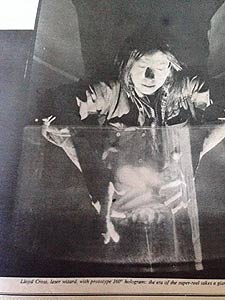
The multiplex hologram was featured on screen in films such as 'Logan's Run' (1977) and 'The Man Who Fell To Earth'(1978), while holography was simulated by VFX fakery in 'Star Wars' also in the late 1970's.
The place of this story in the Sharon McCormack Collection and Archives is confirmed by the close relationship Cross had with Sharon McCormack after her arrival to the School of Holography and Multiplex in the mid 1970's. Together they created some notable holograms, created lenses and printers to improve on Cross' original invention.
A view of Multiplex Co. in 1975 and sample 1974 partner agreement of Lloyd Cross and Dave Schmidt (courtesy Lon Moore)
The original partners in Multiplex Co. included Dave Schmidt and Peter Claudius, who were called the 'pornographers'
by others, all of which adds to the 'drama of things' in these formative years.
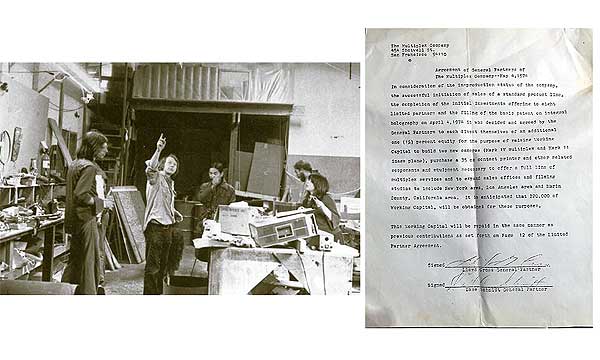
RESOURCES:
'The Story of Multiplex' & School of Holography by Lloyd Cross (.PDF)
John Fairstein's The San Francisco School of Holography (web site with pages)
Lloyd Cross - Bio / Achievements up to 1970 (.PDF)
Jerry Pethick - Bio / Achievements up to 1970 (.PDF)
HISTORY: 1970'S Multiplex Company Catalog - Distribution Flyer
Multiplex Company Catalog - Distribution Flyer late 1970's (.PDF downloadable file)
Visit: Multiplex Apparatus Technology & Printers
The following motion-picture holograms in their original displays are offered for sale. All inquiries can be sent to collection and archives administrator Al Razutis, at the e-mail: alrazutis@ymail.com.
'Masterworks' now available for sale or lease
original motion-picture integral (white light multiplex) holograms
by Lloyd Cross and Sharon McCormack
https://www.alchemists.com/visual_alchemy/smca/masterworks-cross-2021.pdf
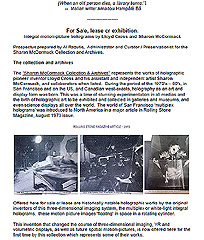
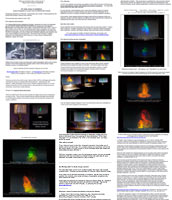
For Sale on a limited time basis:
Integral motion-picture holograms by Lloyd Cross and Sharon McCormack Holographic Collectibles by Sharon McCormack
These holograms are avalable for viewing at Visual Alchemy, Saturna Island, BC, Canada
By appointment only ---
Directions for Getting There
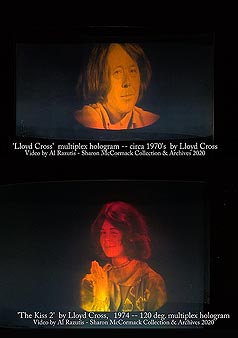
<< Portrait of Lloyd Cross and The Kiss 2 - multiplex holograms - video on YouTube by 'XAR3D 2021'
|
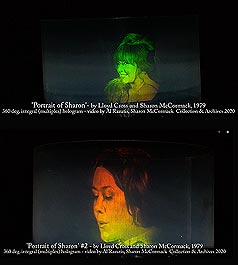
<< Portraits of Sharon McCormack by Lloyd Cross and Sharon McCormack - multiplex holograms - video on YouTube by 'XAR3D 2020'
These original works are of historical significance and set the standards for integral motion-picture holography. They are sold or leased with their original white light and motorized (to rotate) display units and clear cylinders for true display according to their creators' intentions. Please contact Al Razutis at alrazutis@ymail.com to discuss your purchase, exhibition or rental/lease interests. |
|
Sample hologram projection unit - display unit for McCormack Multiplex holographic stereograms ('integrals')- 360 degree motorized cylinder & walk-around view. The 3D image with horizontal parallax only 'floats' in the center of a moving cyliner which is illuminated by a white light bulb. The 3D images move in various actions and in slow motion.
|
A downloadable pdf doc of this 2023 offering is available at https://www.alchemists.com/visual_alchemy/smca/masterworks-cross-2021.pdf

Lloyd Cross collaborations with 'Salvador Dali'
This collection and archives contains famous works by famous arists that were holographically printed by Lloyd Cross, at Multiplex Co. These multiplex holograms are now documented for the Archives in 2D / 3D photos and film by Al Razutis, curator / admin.
Jump to: Holographic experimental films by Simone Forti with Lloyd Cross
'Holographic Art by Salvador Dali' as printed into holograms by Lloyd Cross
'First Cylindric Chromo-Hologram Portrait of Alice Cooper's Brain' by Dali (Salvador Dali, Selwyn Lissack, Lloyd Cross) 1973

"
... in the winter of 1972 Selwyn Lissack who came here and saw our Multiplex 'Lialiana', the multiplex hologram of Leslie and took it back to New York with him on the basis of a little tiny postage stamp hologram sold Salvador Dali a whole expensive program to make a twelve inch high, twenty four inch diameter 360 degree multiplex of Alice Cooper for one of their promotional campaigns... and in over a perdiod of thirty days with literally a telephone call every day, we finally got the filming done in New York in 16 millimeter film and Selwyn brought it out here (to San Francisco) in 1973, I think around February. And that of course sparked the beginning of the Mark II printer. We now had a customer for one of these holograms."
-- Lloyd Cross, inventor of multiplex (integral) holography
( as cited in pages 9 & 10, 'Story of Multiplex' )
2020 Essays by Al Razutis on the subjects of Dali Holograms and who made them and how:
'Being Dali' -- Who made these holograms? How much are they worth?
'First Cylindric Chromo-Hologram Portrait of Alice Cooper's Brain' by Dali, Lissack, and Lloyd Cross. McCormack Collection & Archives copies of two 'sections' from this classic 1973 hologram.

More background and information on 'Alice Cooper's Brain' hologram can be found here in my essay: 'How Much For That Holo?' - Dali Holograms
Web articles:
Pictorial of 'When Alice Cooper Met Salvador Dali in New York, 1973'
'When Salvador Dalí Met Alice Cooper & Turned Him into a Hologram: The Meeting of Two Kings of Camp (1973)'
'Dali Painting Gala' -- Final Dali & Cross Multiplex Hologram
360 degree moving hologram by Dali, as printed by Lloyd Cross, collection copies'Dali Painting Gala' by Salvador Dali (Salvador Dali, Selwyn Lissack, Lloyd Cross) 1976
Multiplex hologram by Lloyd Cross -- SMC&A collection copies - 360 degree integral
View 2 min. video - 'Dali Painting Gala' multiplex hologram on You Tube narrated by A.R. 2020
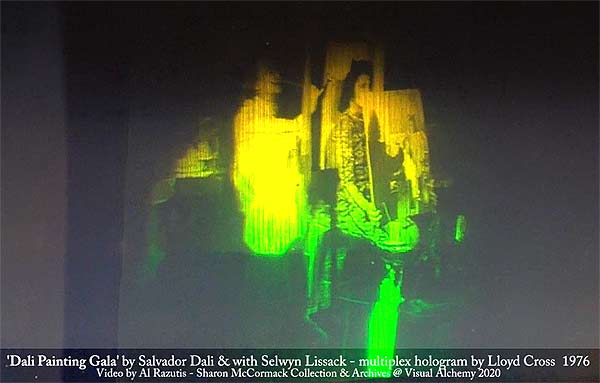
More background and information on 'Dali Painting Gala' hologram can be found here in Al Razutis essay: 'How Much For That Holo?' - Dali / Gala
Lloyd Cross collaborations with Simone Forti
Congratulations to Simone Forti!
|
Biennale Danza 2023
As Wayne McGregor writes in his motivation for the award: "Simone Forti has compiled a body of work – from performance, drawing, film, video, photography, installation, and texts—that is astonishing in its range and singular in its vision. An innovator in multiple mediums and expert dance improviser, Simone Forti’s art has often combined elements of movement, sound, and objects into new and surprising hybrid articulations - work that has been as seminally influential in the development of post-modern dance as it has been revelatory to minimalism.
--------------------------- Simone Forti (Florence, 1935) lives and works in Los Angeles, where she emigrated from Italy in 1938 to escape fascist, anti-Semitic persecution. Her career as a dancer began in the second half of the 1950s when she took part in Anna Halprin’s “Dancers’ Workshop” in San Francisco, experimenting with a new working method based on improvisation, free from the codes of modern dance. In 1959, she moved to New York with then-husband Robert Morris, and studied with Robert Dunn who introduced her to the work of John Cage at the Merce Cunningham studio. In New York, she debuted as a choreographer in 1960 with two dances in the form of a happening - See-Saw and Rollers – and in 1961, Five Dance Constructions and Some Other Things, an evening at Yoko Ono’s loft. These Dance Constructions joined movement and structures for the first time, using everyday actions such as running, climbing, and standing in ropes. The Dance Constructions revolutionized concepts of dance and movement and was a strong influence on the members of Judson Dance Theater, including Trisha Brown, Yvonne Rainer, Steve Paxton, and Robert Morris. She also worked with artist Robert Whitman, performing in the happenings Flower (1960), American Moon (1960), and Prune Flat (1965). In 1968 she presented her minimalist multimedia pieces Face Tunes, Cloths, Songs, Bottom, Book, and Fallers. From 1968 to 1970, she lived in Rome, where she was invited to show her Dance Constructions at Galleria L’Attico by Fabio Sargentini, who also invited her to take part in the Festival Danza Volo Musica e Dinamite together with her American colleagues Trisha Brown, Deborah Hay, Yvonne Rainer, La Monte Young, Marian Zazeela, Terry Riley, and David Bradshaw. For many of them, it was their first European appearance. Also for Sargentini’s L’Attico, Simone Forti created Sleepwalkers, a performance inspired by animal movements she observed at the Rome Zoo. Back in the United States, during the 1980’s and ‘90’s, Forti developed an improvisation practice based on the relationship between words and movement (now known as Logomotion), and her News Animations, speaking and moving on political themes. In the same years, she founded the group Simone Forti and Troupe, and worked with artist Nam June Paik. A total artist, during her career Simone Forti has dedicated herself to drawing, film and video, photography, installation art, and writing. Her works and performances have been shown in the major museums of the world: MoMA, Gugghenheim, Whitney Museum, P.S.1 (New York); Hammer Museum, Getty Museum, Museum of Contemporary Art/MOCA (Los Angeles), San Francisco Museum of Art, Centre Pompidou, Musée du Louvre, Fondation Cartier pour l’art contemporaine (Paris), Carré d'art at Nîmes; Museo Nacional Centro de Arte Reina Sofia (Madrid), Kunsthaus (Zurich), MAMCO (Genève), Kunsthalle (Basle), Hayward Gallery (London), Castello di Rivoli (Turin), Centro Pecci (Prato), Fondazione ICA (Milan), Galleria L’Attico (Roma), Stedelijk (Amsterdam), and many others. A complete solo exhibition of the Italian-American artist’s work is on display at The Museum of Contemporary Art in Los Angeles through April 2nd. |
'The first experimental holographic films made, ever!' (A.R.)
"TWO YEARS before Princess Leia appeared in a flickering blue projection in Star Wars and an actual hologram was used in the science-fiction film Logan’s Run (both 1977), the artist, choreographer, dancer, and writer Simone Forti had begun a collaboration with the holographer Lloyd G. Cross to create moving, three-dimensional holographic versions of several of her dance pieces. "
-- ARTFORUM 2018 https://www.artforum.com/print/201807/solveig-nelson-on-simone-forti-s-holograms-76336
'Striding Crawling' 1977 by Simone Forti, multiplex hologram by Lloyd Cross - gallery installation views - click to enlarge

|
In 1976, Forti and her then-husband, Peter Van Riper, received a Special Projects grant from the National Endowment for the Arts to create a series of multiplex (or integral) holograms. Working with physicist and holographer Lloyd Cross, the process involved shooting a 35mm film of dancer(s) on a revolving platform, then making composite holograms of each frame and mounting them on a transparent cylinder. ---------------------------------------------- "In a 1979 edition of Holosphere magazine, Forti explained that the holographic iterations of her dance works allowed her to “focus in on one move,” making it possible for the viewer to find “many things to see” within a single complete action. In an interview, she has spoken of their similarity to haikus. Take, for example, the work in the lacma show, which Forti has presented in live, videotaped, and holographic forms from 1974 to today. In performances of the work, Forti walks, drops into a crawl, and then strides again without a break in momentum. The holographic versions of Striding Crawling, by contrast, isolate a single transition between “standing erect and lowering oneself to the floor,” as Forti put it recently. In this form, the piece unfolds as a loop rather than a narrative progression. As the viewer proceeds clockwise or counterclockwise around the Plexiglas support, the image of Forti moves correspondingly backward or forward, growing larger or smaller depending on the viewer’s proximity. Sometimes the hologram disappears altogether or seems to slow to a standstill. All the while, a small change in position—even something as slight as a turn of the head—produces transformations in green, yellow, blue, and red." ( ... ) "Making these so-called multiplex holograms was a complicated process. Cross filmed Forti performing on a rotating platform, requiring her to move very slowly, and limiting each sequence to forty-five seconds for the 360-degree holograms (and shorter durations for holograms not filling an entire Plexiglas cylinder). The processed film was then put into a purpose-built holographic printer comprising a projector, a laser, a beam splitter, and various kinds of lenses. Using this device, each individual frame (representing a change of about a third of a degree in the viewing position) was then embedded into a holographic film and carefully mounted on the Plexiglas support. When the resulting hologram is illuminated from within, the viewer sees thousands of vertical slits, resembling television scan lines, within the Plexi’s curved pane. Each of our eyes registers a slightly different sequence of the marginally overlapping slits, and our brains fuse them together stereoscopically to create the image of a body in motion. Unlike the photographic stereogram, in which we see two photographs whose perspectives are combined to create the illusion of depth, Cross’s method produces a sequence of holograms that the viewer can approach "in the round" without being confined to a fixed position." ( ... ) "In fact, as if in response to the accomplishment that Cross’s three-dimensional moving pictures represented at the time, Forti’s holograms exploit their technical limitations. When one moves around these works, a second, harmonic hologram sometimes appears, and from certain perspectives Forti’s hands begin to stretch and blur thanks to what holographers call "time smear," visualizing that we are seeing a composite image recorded at different times. As Forti once wrote, these glitches in the holographic recording of her movements allow "glimpses into the immediate future of the moment in view," which "appear as displacements in space." But as she suggests in her 1978 book of poems, Angel, they also generate something weirder. Here, Forti describes a hologram also titled Angel, 1976, in which she performs a condensed dance movement consisting of an inhalation and exhalation: "The arm was wrong because it did not hold symmetrically with the action of the other arm but smeared along lagging behind while surely originally I had moved my arms together while turning on the turntable before the turning camera recording my slow action of deep intake of breath opening the hinges of my shoulders, arms moving back unfeathered but remembering. That part was there, the arms went back alright, counterbalancing the for- ward leaning form, but with the outrushing of breath compressing the bellows of ribs and belly, closing the shoulder hinges, the arms swooped forward, the left passing through a time warp giving the sequence a whole other look, a whole other intention of its own." -- Solveig Nelson for ARTFORUM (2018) |
'Striding Crawling' 1977 by Simone Forti, multiplex hologram by Lloyd Cross - sequential frames - click to enlarge

View 2 min. video clip on YouTube:
https://youtu.be/HHS0BYZ7MmM

First holographic experimental films by Forti & Cross!
A recent discovery of 'experimental holographic films by Simone Forti and Lloyd Cross, 1976-1977,
lends to added excitement of the work of these holographic art pioneers!
A curator's notes sheds light on these experimentations. They are not attempting verysimilitude here:
|
"In fact, as if in response to the accomplishment that Cross’s three-dimensional moving pictures represented at the time, Forti’s holograms exploit their technical limitations. When one moves around these works, a second, harmonic hologram sometimes appears, and from certain perspectives Forti’s hands begin to stretch and blur thanks to what holographers call "time smear," visualizing that we are seeing a composite image recorded at different times. As Forti once wrote, these glitches in the holographic recording of her movements allow "glimpses into the immediate future of the moment in view," which "appear as displacements in space." -- Solveig Nelson for ARTFORUM (2018) |
Video recording (by AR) samples of the experimental works are on-line, call it a "virtual museum version" and contained in XAR3D CHANNEL on You Tube at the following links:
First experimental holographic mopvies, created by Lloyd Cross and Simone Forti, both seminal and sometime overlooked figures in the evolution of holography.
These works are now relocated to a permanent home and gallery at the The Box LA in Los Angeles, California where they will be preserved in perpetuity.
|
The images in Forti’s multiplex holograms "are not at all stylized," as she later recalled, "but all about the body organizing itself to fulfill a necessity. I have often felt that dancing makes it hard to really see the body because it is moving around in so many ways and directions." More than documents of her "Dance Constructions," Forti’s holograms became dancers themselves when she installed and interacted with them in performance spaces." The hologram Striding Crawling (1976–78), was recently acquired by LACMA and is currently on view in the exhibition 3D: Double Vision in the Art of the Americas Building through April 1, 2019.
|
Multiplex Apparatus & Technology in the Sharon McCormack Archives
History
The Multiplex printer idea came from Lloyd Cross
U.S. Patent Application for original multiplex (integral) hologram printer by Lloyd Cross
-- 1973 draft copy unfiled sample pages

Download PDF copy
Multiplex Holographic Printer Patent Applicaton - by Lloyd Cross
- 21 pages, 1 illustration, document courtesy of Lon Moore
First person historical accounts:
'The Story of Multiplex' & School of Holography by Lloyd Cross (.PDF)
Photo of (l to r) Lloyd Cross, Michael Kan, the principal designer - builders of the multiplex hologram printer & lenses, and Dr. Tung Jeong from Wake Forest College Physics Dept, a visitor to the School of Holography - Multiplex Shotwell Street San Francisco building , circa 1974 photo. Source: Sharon McCormack Collection & Archives.

John Fairstein's account 'The San Francisco School of Holography' (web site with pages)
NOTE: the terms 'multiplex hologram', 'integral hologram' and 'holographic stereogram', are used interchangeably here., as they appear to be used interchangeably in the 1970's.
NOTE ALSO: It is clear from the documentation provided here that Lloyd Cross 'invented WLT multliplex holography' not from scratch but as a invention that acknowledged 'prior art' and featured notable improvements on what had existed before. It is also clear that the inventor of the 'white light transmission hologram' (the 'Rainbow hologram') was Dr. Steve Benton. Together with Benton's idea, Cross invented the multiplex movie hologram, and that's a fact.
Expert technical descriptions of multiplex holography by others, history and subsequent improvements:
Method and System for Constructing a Composite Hologram by K. Haines, Eidetic Images, 1982 (.PDF)
Multiplex holography: some new methods by E.N. Leith & P. Voulgaris, SPIE 1985 (.PDF)
The Generalized Holographic Stereogram
by Michael W. Halle, MIT 1988 (.PDF)
Holographic Optical Elements
for Holographic Stereogram Printers by M. Klug, MIT 1989 (.PDF)
Optics for Full-parallax Holographic Stereograms by Michael A. Klug, SPIE 1997 (.PDF)
Multiplex turntable and camera - with Lloyd Cross and laser multiplex holograms ROLLING STONE MAGAZINE ARTICLE - 1973



Below, Al Razutis @ Visual Alchemy 2017 pictured with laser transmission multiplex hologram, similar as pictured in Rolling Stone Magazine 1973 article on Multiplex Company A State of the Art Report Holography by Michael Rogers.
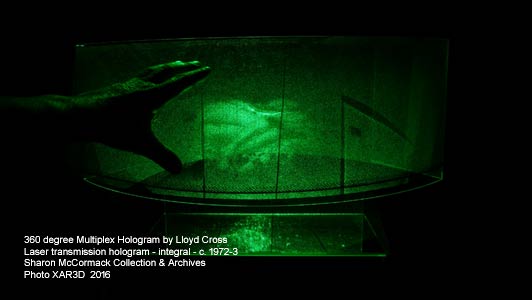
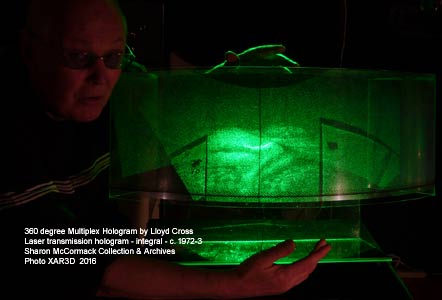
Sharon McCormack in the 1980's shooting multiplex subjects and personalities
Holographic Stereogram or Integrals Printers & Design Technology
Multiplex Mark III Printer - Diagram - Photos Sharon McCormack Collection & Archives
Mark III Optical Printer for Holographic Stereograms at Multiplex Company - photo John Fairstein
See John Fairstein's histories of The San Francisco School of Holography (web site with pages)
Multiplex Mark IV Printer - Diagram - Photos Sharon McCormack Collection & Archives
Multiplex Mark V Printer - Diagram - Sharon McCormack Collection & Archives
Tunable Cylindrical Lens and Collimating Lens for Mark V Printer constructed by Sharon McCormack
Sharon McCormack photo with her tunable lenses in Collection & Archives
Helium-Neon Laser used by Sharon McCormack and Subject Turntable Apparatus - Collection & Archives
Sample hologram projection unit - display unit for McCormack holographic stereograms - 360 degree cylinder & walk-around view.

Photos of Lloyd Cross and Sharon McCormack - Multiplex and School of Holography
Lloyd Cross and Sharon McCormack worked together in the 1970's to develop the optical technology for the "Mark III" and later optical printers used in the production of Multiplex holographic stereogram movies. These movies increased in size and duration from 120 degree movies to 360 degrees, and contemplated for reel to reel displays as well. The 'tunable lenses' of the Multiplex printers allowed them to create Multiplex holographic stereograms (integrals) of unsurpassed quality. These lenses were widely shared and distributed. Photos from the Sharon McCormack Collection & Archives.
Early Multiplex and School of Holography Histories referenced here:
'The Story of Multiplex' & School of Holography by Lloyd Cross (.PDF)
John Fairstein's The San Francisco School of Holography (web site with pages)
Lloyd Cross - Bio / Achievements up to 1970 (.PDF)
Jerry Pethick - Bio / Achievements up to 1970 (.PDF)
Multiplex Company Catalog - Distribution Flyer late 1970's
Multiplex Company Catalog - Distribution Flyer late 1970's (.PDF downloadable file)
SAN FRANCISCO SCHOOL OF HOLOGRAPHY
Founded by Lloyd Cross and Jerry Pethick 1971
Dr. Lloyd Cross, a physicist previously engaged at Willow Run Labs in Michigan joined forces with Jerry Pethick, a Canadian artist educated in England also interested in holography, and went to San Francisco and created a School of Holography for artists and artisans, with home-made lab equipment available for people outside of labs. During this time in 1972-73 Lloyd Cross invented 'the Multiplex white-light transmission motion-picture hologram' and formed a company with film-makers and holographers he had trained, the MULTIPLEX COMPANY to produce, distribute, educate and disseminate white-light transmission motion-picture holographic stereograms across the world.
NOTA BENE: What's also interesting is that these two partners Cross and Pethick had worked to create the first 'holographic art exhibitions' to happen in North America in the late 1960's. This story is told HERE

Photo of Jerry Pethick (left) and Lloyd Cross (right) - circa 1970 - collection of Margaret Pethick.
The San Francisco School of Holography was the predecessor to 'Multiplex company' and multiplex activities. The multiplex (integral) printers were first developed there. Its philosophy of 'knowledge should be free' directly led to the creation of a vibrant culture of holographic artists, holographic entrepreneurs and production facilities on the west-coast and world-wide. This culture existed beyond the boundaries of any 'university'.
Lloyd Cross - Bio / Achievements up to 1970 (.PDF)
SOH listing by Cross of 'Permanent Directors' and 'Founders Shares'
'to include some who just dropped by regularly', and as appointed by Lloyd Cross (courtesy Lon Moore):
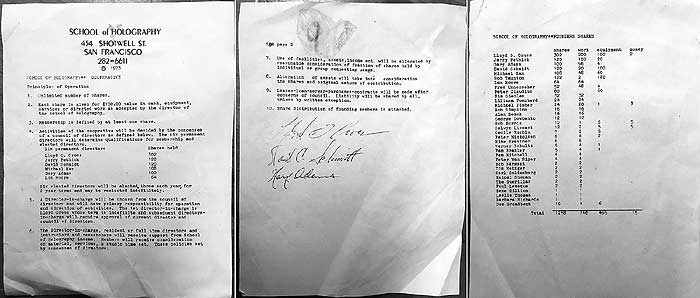
This first of its kind San Francisco School of Holography from 1971 would produce a number of future teachers, artists, and artisans creating and exhibiting in holography. And Multiplex holograms would catch on globally and feature more sophisticated methods of creating motion-pictures in rotating cylinders. This was the 70's - 80's of experimental artistic practices which informed later decades in the arts and displays of holography.
Invention and construction of Multiplex printers took place at the San Francisco School of Holography under direction of Lloyd Cross.
The Linda Lane 'Laser Lady Meets the Light Junkies' book contains diary notes on the building of a multiplex printer for the making of Dali Alice Cooper hologram

First person historical accounts of School of Holography & Multiplex Co.:
'The Story of Multiplex' & School of Holography by Lloyd Cross (.PDF)
John Fairstein's The San Francisco School of Holography (web site with pages)
-- Read more excerpts on the school & multiplex printer history by Fairstein - above
Return of the 'School of Holography' in the 1970's
In the later 1970's Sharon McCormack, Lloyd Cross and Michael Kan resumed teaching holography under the banner of 'School of Holography', now located just down the street at 550 Shotwell St., after the original school had ceased operations when the sand table rooms (for exposing holograms) were taken over by 'Multiplex Co.' Sample scans of SF School of Holography offered by McCormack, Cross, Kan in 1978 at her home location show the pamphlet / promotional material. Sharon McCormack Collection & Archives 2016.
School of Holography Project - 50 ft. rainbow for exhibition
SF SCHOOL OF HOLOGRAPHY INSTALLS MULTIPLEX IN CHICAGO 1977
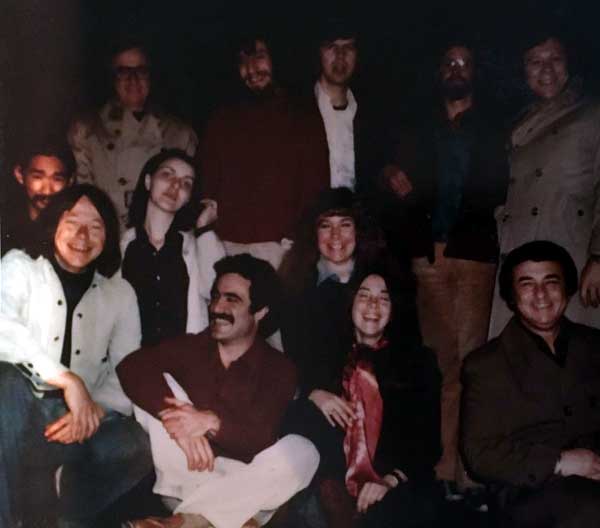
Lloyd Cross and SF School of Holography install multiplex technology in Chicago 1977
- group photograph along with Chicago people - courtesy of Lon Moore
Historical background on early SF School of Holography and Multiplex Company:
'The Story of Multiplex' & School of Holography by Lloyd Cross (.PDF)
Lloyd Cross - Bio / Achievements up to 1970 (.PDF)
'The San Francisco School of Holography' by John Fairstein
